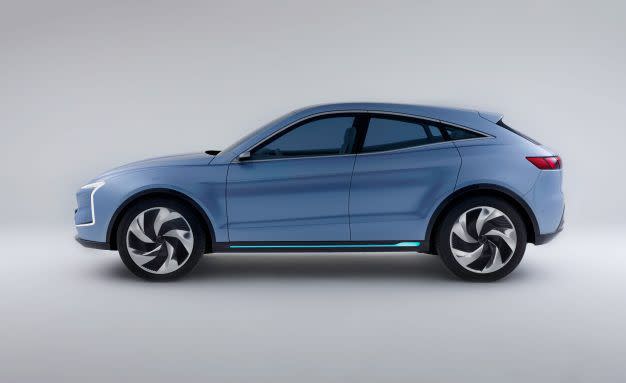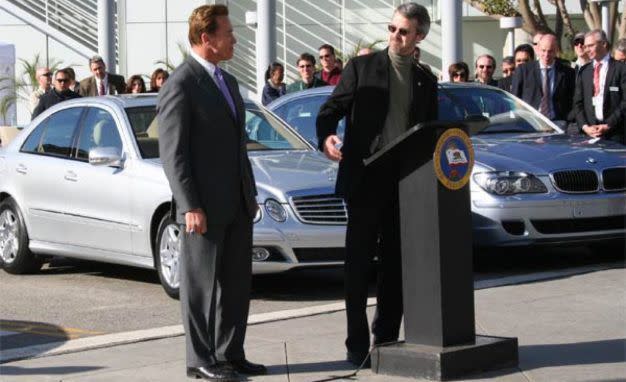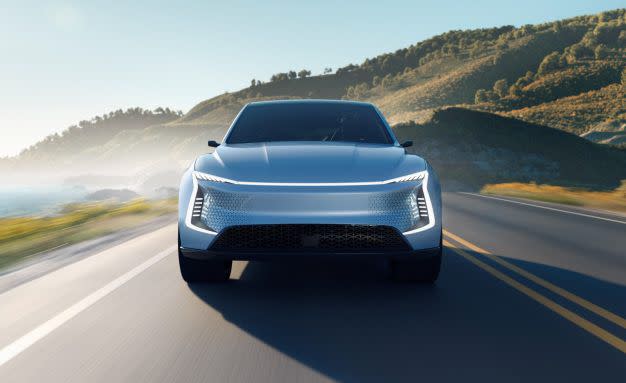Chinese-Funded SF Motors Lays Out Plan for EVs
Chinese-funded EV startup SF Motors emerged from stealth mode recently, revealing a pair of electric sport-utility vehicles that its founder and CEO John Zhang said he hopes will “transform human mobility-and perhaps our planet.”
At an event held at the company’s U.S. headquarters in Santa Clara, California, details on the strikingly designed vehicles were sparse, and company officials were reluctant to give specifics. The SF5 is a mid-size premium crossover that Zhang says will be available for preorder by the end of this year and be on the road in 2019. The SF7 is a full-size performance crossover with four motors delivering torque vectoring, all-wheel drive, and more than 1000 horsepower-and a targeted zero-to-60-mph time of less than three seconds. No prices were announced.
The cars will be built at highly automated factories in the United States and China, the company claimed, with trial production starting later this year and eventually ramping up to 200,000 vehicles annually. “We can’t follow the same path as every other EV company,” said Zhang. “We aim to be the company that shares integrated technology solutions and provides the manufacturing expertise to make more EVs a reality.”

SF Motors is developing its own powertrain and recyclable batteries. The company would not discuss the capacity of battery packs (or the chemistry, likely to be lithium-ion) but said the vehicles will have an EPA-cycle range of 300 miles. An optional gasoline-powered range extender will be available. Zhang said SF will make its powertrain available to other startups in flexible one-, two-, three-, or four-motor configurations.
Following the Tesla Trail
This aspiring Tesla rival is technically American. It was founded in 2016 with a $30 million investment from Chongqing Sokon Industry Group, a Chinese maker of trucks and vans. The company toyed with acquiring California engineering firm AC Propulsion, which licensed lithium-ion battery technology to Tesla for the first Roadster. As Car and Driver revealed last year, this deal never went through. Sokon finally acknowledged that earlier this month.

Instead, Tesla co-founder Martin Eberhard persuaded SF to buy his company, a firm called InEVit that had been working with European OEMs on EV batteries. Eberhard is now SF’s chief innovation officer. Last year, SF also set up a research center in Ann Arbor, Michigan, and bought a former Humvee assembly plant in Indiana, where its U.S.-market vehicles will be made. Vehicles for the China market will come from a factory in Chongqing that’s more than 10 times as large. Both plants will be among the most automated in the world, says SF, with body shops and process quality control centers that are 100 percent automated.
But SF still needs plenty of humans. Just weeks after acquiring InEVit in October, the company was awarded a $7.5 million California tax credit. To receive it, SF Motors needs to increase its employee count from 95 at the end of last year to 370 by 2021 and invest nearly $11 million in the state. SF’s chief production officer, Jim Finn, said the company will employ 3500 workers at its two factories.
In December 2017, Sokon reorganized its corporate structure to give SF Motors more independence and boosted SF’s capitalization to $60 million. A document filed with Chinese regulators in 2016 says that Sokon eventually intends to invest a total of $590 million. That may sound like a lot, but it would be a relatively modest sum to develop, manufacture, sell, and service a range of new EVs in the world’s two largest car markets.

Sokon has not entirely cut SF loose, however. In January, Sokon broke ground on a $45 million battery plant in China that is expected to produce 5.2 gigawatt-hours of cells by 2021. This is about a seventh the size of Tesla’s Gigafactory in Nevada. Battery cells would then be shipped to the factories and made into packs on-site.
SF says that self-driving will initially be focused on what it calls “protective autonomy,” in which the car mostly drives itself while the driver, still in charge, provides some limited input. It’s testing such technology in California, Michigan, and China and now says that it has multiple test vehicles, although when it began testing it requested a permit from the California Department of Motor Vehicles for just a single car, a Lincoln MKZ. The technology also appears to be relatively unsophisticated, however. The company told the California DMV that automated lane changing, intersection handling, and parking are still in development.
Talking the Talk, but . . .
SF Motors executives also touched on just about every high-tech buzzword, including voice control, visual recognition of owners, deep neural networks, software that adjusts dynamically to different drivers, solid-state batteries, and packs having a second life as domestic energy storage. The cars will have a large screen between the driver and passenger, similar to that of a Tesla Model S.
“Building an EV conceptual model is easy,” said John Zhang, who offered several not-so-veiled jabs at Tesla and its manufacturing fumbles. “But mass production of [a] high-quality EV is difficult and none of the other EV companies are doing that. We will change that. We will deliver at scale with extremely high quality.”
If the first SF5 is really going to come off an assembly line by the end of next year, the clock is ticking very loudly.
You Might Also Like

 Yahoo Autos
Yahoo Autos 